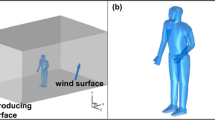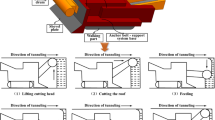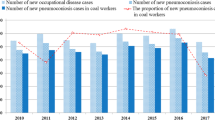Abstract
During the excavation of high gas mine, gas and dust often exist at the same time. In order to ensure that the gas concentration remains within a safe range and minimize the risk of workers’ pneumoconiosis, we simulated the interaction mechanism of airflow, gas, and dust, explored the pollution law of gas and dust, and obtained the optimal purification distance (Lp) by the CFD method. The reliability of the numerical simulation was verified by field measurements. Firstly, the properties of the gas and dust affected the structure of the airflow field. At the same time, the change in the airflow field affected the concentration distributions of the gas and dust. During the diffusion process, some high-risk regions in which the gas or dust concentrations exceeded 0.80% or 200 mg/m3, respectively, were discovered. Moreover, we have found that the airflow velocity in the top region of the tunnel and at the intersection corner between the cutting face and tunnel wall was the main factor affecting the purification effects. When Lp = 5–8 m, the gas concentration remained below 0.50%. When Lp = 6 m, the dust concentration reached a minimum of 287.5 mg/m3. Therefore, the optimal purification distance was determined to be 6 m; in which case, the gas and dust concentrations decreased by 32.84% and 47.02%, respectively.













Similar content being viewed by others
References
Alden CB, Wright RJ, Coburn SC, Caputi D, Wendland G, Rybchuk A, Conley S, Faloona I, Rieker GB (2020) Temporal variability of emissions revealed by continuous, long-term monitoring of an underground natural gas storage facility. Environ Sci Technol 54:14589–14597. https://doi.org/10.1021/acs.est.0c03175
Cardoso-Saldana FJ, Allen DT (2020) Projecting the temporal evolution of methane emissions from oil and gas production sites. Environ Sci Technol 54:14172–14181. https://doi.org/10.1021/acs.est.0c03049
Chen DW, Nie W, Xiu ZH, Yang B, Du T, Liu Q, Peng HT (2022a) Research on environmental dust pollution: ventilation and dust space–time evolution law of a fully mechanized mining face with 7-m mining height. Environ Sci Pollut Res 29(22):33627–33644. https://doi.org/10.1007/s11356-021-17967-5
Chen JT, Li H, Chu YY, Zhang Y, Tang DZ, Zhu J, Li WX, Wang KY (2022b) Influence of stiffness difference on rock fracture based on particle flow simulation. J Shandong Univ of Sci Technol (Natural Science) 41:51–59. https://doi.org/10.16452/j.cnki.sdkjzk.2022.02.006
Chen YS, Hsu CJ, Hsiau SS, Ma SM (2016) Clean coal technology for removal dust using moving granular bed filter. Energy 120:441–449. https://doi.org/10.1016/j.energy.2016.11.093
Chen SY, Zhang XR, Lin JT, Huang JP, Zhao D, Yuan TG, Huang KN, Luo Y, Jia Z, Zang Z, Qiu YA, Xie L (2019) Fugitive road dust PM2.5 emissions and their potential health impacts. Environ Sci Technol 53:8455–8465. https://doi.org/10.1021/acs.est.9b00666
Cheriyan D, Choi JH (2020) A review of research on particulate matter pollution in the construction industry. J Clean Prod 254. https://doi.org/10.1016/j.jclepro.2020.120077
Cowie CT, Rose N, Gillett R, Walter S, Marks GB (2012) Redistribution of traffic related air pollution associated with a new road tunnel. Environ Sci Technol 46:2918–2927. https://doi.org/10.1021/es202686r
Cui PY, Li Z, Tao WQ (2014) Investigation of re-independence of turbulent flow and pollutant dispersion in urban street canyon using numerical wind tunnel (NWT) models. Int J Heat Mass Transf 79:176–188. https://doi.org/10.1016/j.ijheatmasstransfer.2014.07.096
Ding S, Huang YD, Cui PY, Wu J, Li MZ, Liu DT (2019) Impact of viaduct on flow reversion and pollutant dispersion in 2D urban street canyon with different roof shapes-numerical simulation and wind tunnel experiment. Sci Total Environ 671:976–991. https://doi.org/10.1016/j.scitotenv.2019.03.391
Ebrahimi-Moghadam A, Farzaneh-Gord M, Arabkoohsar A, Moghadam AJ (2018) CFD analysis of natural gas emission from damaged pipelines: correlation development for leakage estimation. J Clean Prod 199:257–271. https://doi.org/10.1016/j.jclepro.2018.07.127
Fang Y, Fan JG, Kenneally B, Mooney M (2016) Air flow behavior and gas dispersion in the recirculation ventilation system of a twin-tunnel construction. Tunn Undergr Sp Tech 58:30–39. https://doi.org/10.1016/j.tust.2016.04.006
Fittschen UEA, Santen M, Rehmers A, Durukan I, Wesselmann M (2013) Indoor aerosol determination with respect to a soiling phenomenon in private residences. Environ Sci Technol 47:608–615. https://doi.org/10.1021/es303281k
Geng F, Gui CG, Wang YC, Zhou FB, Hu SY, Luo G (2019) Dust distribution and control in a coal roadway driven by an air curtain system: a numerical study. Process Saf Environ Prot 121:32–42. https://doi.org/10.1016/j.psep.2018.09.005
Goldasteh I, Ahmadi G, Ferro AR (2013) Monte Carlo simulation of micron size spherical particle removal and resuspension from substrate under fluid flows. J Aerosol Sci 66:62–71. https://doi.org/10.1016/j.jaerosci.2013.07.012
Guan L, Gu ZZ, Yuan ZL, Yang LJ, Zhong WQ, Wu YY, Sun SS (2016) Numerical study on the penetration of ash particles in a three-dimensional randomly packed granular filter. Fuel 163:122–128. https://doi.org/10.1016/j.fuel.2015.09.056
Huang CY, Chen XF, Liu LJ, Zhang HM, Yuan BH, Li Y (2021) The influence of opening shape of obstacles on explosion characteristics of premixed methane-air with concentration gradients. Process Saf Environ Prot 150:305–313. https://doi.org/10.1016/j.psep.2021.04.028
Huang XY, Ji Q, Zhang XT, Jiao SJ, Wei HX (2022) Numerical simulation research on rock breaking mechanism of four-hole cut blasting under ground stress. J Shandong Univ of Sci Technol (Natural Science) 41:60–69. https://doi.org/10.16452/j.cnki.sdkjzk.2022.02.007
Kurnia JC, Sasmito AP, Mujumdar AS (2014) CFD simulation of methane dispersion and innovative methane management in underground mining faces. Appl Math Model 38:3467–3484. https://doi.org/10.1016/j.apm.2013.11.067
Li CW, Zhao YC, Ai DH, Wang QF, Peng ZG, Li YJ (2020) Multi-component LBM-LES model of the air and methane flow in tunnels and its validation. Physica A 553. https://doi.org/10.1016/j.physa.2020.124279
Li YY, Yan HD, Zhang SC, Zhang L, Zhang SL, Li ZK (2022) Experimental study on the expansion law and mechanical characteristics of crack propagation in rock with composite defect. J Shandong Univ of Sci Technol (Natural Science) 41:42–50. https://doi.org/10.16452/j.cnki.sdkjzk.2022.02.005
Liu Q, Nie W, Hua Y, Peng HT, Liu CQ, Wei CH (2019) Research on tunnel ventilation systems: Dust Diffusion and Pollution Behaviour by air curtains based on CFD technology and field measurement. Build Environ 147:444–460. https://doi.org/10.1016/j.buildenv.2018.08.061
Liu W, Xu H, Wu DY, Qin YP, Liu J, Zhao W (2021a) Gases migration behavior of adsorption processes in coal particles: density gradient model and its experimental validation. Process Saf Environ Prot 152:264–277. https://doi.org/10.1016/j.psep.2021.06.014
Liu N, Sun LL, Qin BT, Zhang SH, Du WZ (2021b) Evolution of pore and fracture of coal under heating–freezing effects: An experimental study. Fuel 306:121618. https://doi.org/10.1016/j.fuel.2021.121618
Mitchell AL, Tkacik DS, Roscioli JR, Herndon SC, Yacovitch TI, Martinez DM, Vaughn TL, Williams L, Sullivan M, Floerchinger C, Omara M, Subramanian R, Zimmerle D, Marchese AJ, Robinson AL (2015) Measurements of methane emissions from natural gas gathering facilities and processing plants: measurement results. Environ Sci Technol 49:12602–12602. https://doi.org/10.1021/acs.est.5b04018
Mo ZW, Liu CH (2018) Wind tunnel measurements of pollutant plume dispersion over hypothetical urban areas. Build Environ 132:357–366. https://doi.org/10.1016/j.buildenv.2018.01.046
Nagaosa RS (2014) A new numerical formulation of gas leakage and spread into a residential space in terms of hazard analysis. J Hazard Mater 217:266–274. https://doi.org/10.1016/j.jhazmat.2014.02.033
Nie W, Guo C, Zhang SB, Peng HT, Xu CW, Ma QX, Yuan MY, Zhou WW, Guo LD, Cheng L (2022a) Optimization of spraying dust reduction technology of continuous miner machine and the dust environment in a tunnel based on computational fluid dynamics (CFD) technology. Powder Technol 398:117044. https://doi.org/10.1016/j.powtec.2021.117044
Nie W, Liu XF, Liu CY, Guo LD, Hua Y (2022b) Prediction of dispersion behavior of typical exhaust pollutants from hydraulic support transporters based on numerical simulation. Environ Sci Pollut Res 29(25):38110–38125. https://doi.org/10.1007/s11356-021-17959-5
Nie W, Hua Y, Zhou WW, Liu Q, Cai XJ, Cheng L (2022c) Design and application of a dust suppression technology of the forcing air curtain in fully mechanized rock tunnelling faces. Environ Sci Pollut Res 29(23):34943–34954. https://doi.org/10.1007/s11356-022-18623-2
Nie W, Sun N, Liu Q, Guo LD, Xue QQ, Liu CY, Niu WJ (2022d) Comparative study of dust pollution and air quality of tunnelling anchor integrated machine working face with different ventilation. Tunn Undergr Space Technol 122:104377. https://doi.org/10.1016/j.tust.2022.104377
Nie W, Ma QX, Cai XJ, Peng HT, Xu CW, Guo C, Zhang SB, Cheng L (2022e) A multi-indicator orthogonal investigation into the dust suppression effect of a shearer-mounted negative-pressure spraying device. Powder Technol 399:117135. https://doi.org/10.1016/j.powtec.2022.117135
Nie W, Zhou WW, Li N, Yuan MY, Yan JY, Hua Y, Bao Q, Yu FN, Niu WJ (2022f) The Novel Monolithic Pr1-xCexCo0.5Mn0.5O3 Oxides Catalysts for the Selective Catalytic Reduction of NOx by NH3. Catal Letters. https://doi.org/10.1007/s10562-022-03922-7
Nie W, Yang B, Du T, Peng HT, Zhang X, Zhang YL (2022g) Dynamic dispersion and high-rise release of coal dust in the working surface of a large-scale mine and application of a new wet dust reduction technology. J Clean Prod 351:131356. https://doi.org/10.1016/j.jclepro.2022.131356
Nie W, Yuan MY, Bao Q, Yan JY, Zhou WW, Guo C, Guo LD, Niu WJ, Yu FN, Hua Y (2022h) Experimental and molecular dynamics simulation research on compound dust suppressant based on locust bean gum. Adv Powder Technol 33(3):103485. https://doi.org/10.1016/j.apt.2022.103485
Nie W, Zhang X, Peng HT, Chen DW, Du T, Yang B, Liu CY (2022i) Research on air curtain dust control technology for environmental protection at fully mechanized working faces. Environ Sci Pollut Res. https://doi.org/10.1007/s11356-022-18775-1
Niu WJ, Nie W, Yuan MY, Bao Q, Zhou WW, Yan JY, Yu FN, Liu CY, Sun N, Xue QQ (2021) Study of the microscopic mechanism of lauryl glucoside wetting coal dust: Environmental pollution prevention and control. J Hazard Mater 412:125223. https://doi.org/10.1016/j.jhazmat.2021.125223
Peng HT, Nie W, Zhang SB, Cheng WM, Liu Q, Guo C, Ma QX, Zhou ZL, Xu CW, Hua Y, Zhang H (2022) Research on negative pressure jet dust-removal water curtain technology for coal mine cleaner production. Fuel 310:122378. https://doi.org/10.1016/j.fuel.2021.122378
Sasmito AP, Birgersson E, Ly HC, Mujumdar AS (2013) Some approaches to improve ventilation system in underground coal mines environment - a computational fluid dynamic study. Tunn Undergr Sp Tech 34:82–95. https://doi.org/10.1016/j.tust.2012.09.006
Schulz D, Schwindt N, Schmidt E, Jasevicius R, Kruggel-Emden H (2019) Investigation of the dust release from bulk material undergoing various mechanical processes using a coupled DEM/CFD approach. Powder Technol 355:37–56. https://doi.org/10.1016/j.powtec.2019.07.005
Shen D, Wu S, Li ZJ, Tang Q, Dai PY, Li YS, Li CM (2019) Distribution and physicochemical properties of particulate matter in swine confinement barns. Environ Pollut 250:746–753. https://doi.org/10.1016/j.envpol.2019.04.086
Song YF, Zhang Q (2019) Quantitative research on gas explosion inhibition by water mist. J Hazard Mater 363:16–25. https://doi.org/10.1016/j.jhazmat.2018.09.059
Sun LL, Wang HS, Zhang C, Zhang SH, Liu N, He ZL (2021) Evolution of methane ad-/desorption and diffusion in coal under in the presence of oxygen and nitrogen after heat treatment. J Nat Gas Sci Eng 95:104196. https://doi.org/10.1016/j.jngse.2021.104196
Tong RP, Cheng MZ, Yang XY, Yang YY, Shi M (2019) Exposure levels and health damage assessment of dust in a coal mine of Shanxi Province, China. Process Saf Environ Prot 128:184–192. https://doi.org/10.1016/j.psep.2019.05.022
Toraño J, Torno S, Menendez M, Gent M, Velasco J (2009) Models of methane behaviour in auxiliary ventilation of underground coal mining. Int J Coal Geol 80:35–43
Wang ZW, Li SG, Ren T, Wu JM, Lin HF, Shuang HQ (2019) Respirable dust pollution characteristics within an underground heading face driven with continuous miner - a CFD modelling approach. J Clean Prod 217:267–283. https://doi.org/10.1016/j.jclepro.2019.01.273
Wang PF, Han H, Liu RH, Gao RZ, Wu GG (2020a) Effect of outlet diameter on atomization characteristics and dust reduction performance of X-swirl pressure nozzle. Process Saf Environ Prot 137:340–351. https://doi.org/10.1016/j.psep.2020.02.036
Wang PF, Han H, Tian C, Liu RH, Jiang YD (2020b) Experimental study on dust reduction via spraying using surfactant solution. Atmos Pollut Res 11:32–42. https://doi.org/10.1016/j.apr.2020.02.010
Xu G, Chen YP, Eksteen J, Xu JL (2018) Surfactant-aided coal dust suppression: a review of evaluation methods and influencing factors. Sci Total Environ 639:1060–1076. https://doi.org/10.1016/j.scitotenv.2018.05.182
Yu YS, Tao YB, Sun J, He YL (2020) Molecular dynamics simulation on agglomeration and growth behavior of dust particles during flue gas filtration. Powder Technol 362:493–500. https://doi.org/10.1016/j.powtec.2019.10.029
Zhang J, Wang XL, Chen HC, Liu XP, Sun YF (2008) Simulation on ventilation and dust diffusion on heading face of the diversion tunnel. J Hydroelectric Eng 27:111–117
Zhou D, Feng ZC, Zhao D, Zhao YS, Cai TT (2017) Experimental meso scale study on the distribution and evolution of methane adsorption in coal. Appl Therm Eng 112:942–951. https://doi.org/10.1016/j.applthermaleng.2016.10.164
Zhu HQ, Zhu SH, Jia GW (2014) Numerical simulation of optimum height of press-in air duct for large section tunneling. J Safety Environ 25–28. https://doi.org/10.13637/j.issn.1009-6094.2014.01.007
Data availability
All data generated or analyzed during this study are included in this published article [and its supplementary information files].
Funding
This work has been funded by the National Natural Science Foundation of China (NO. 51874191 and 52174191), the National Key R&D Program of China (2017YFC0805201), Qingchuang Science and Technology Project of Shandong Province University (2020KJD002), and the Taishan Scholars Project Special Funding (TS20190935).
Author information
Authors and Affiliations
Contributions
Lidian Guo, conceptualization, creation of models, software, methodology, writing — original draft, and review and editing. Wen Nie, conceptualization, data curation, writing — original draft preparation, and software. Hai Yu, investigation, conceptualization, methodology, software, and creation of models. Qiang Liu, investigation, software, validation, and writing — original draft. Yun Hua, validation, software, and creation of models. Qianqian Xue, investigation and software. Ning Sun, investigation and review and editing.
Corresponding author
Ethics declarations
Ethics approval and consent to participate
Not applicable
Consent for publication
Not applicable.
Competing interests
The authors declare no competing interests.
Additional information
Responsible Editor: Shimin Liu
Publisher’s note
Springer Nature remains neutral with regard to jurisdictional claims in published maps and institutional affiliations.
Rights and permissions
About this article
Cite this article
Nie, W., Guo, L., Yu, H. et al. Study on dust–gas coupling pollution law and selection of optimal purification distance of air duct during tunneling process. Environ Sci Pollut Res 29, 74097–74117 (2022). https://doi.org/10.1007/s11356-022-20995-4
Received:
Accepted:
Published:
Issue Date:
DOI: https://doi.org/10.1007/s11356-022-20995-4




